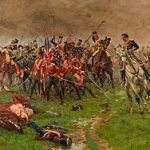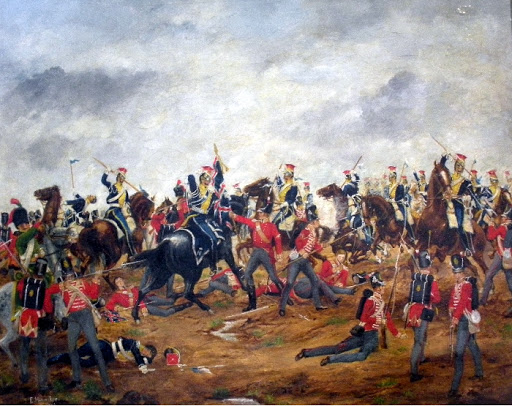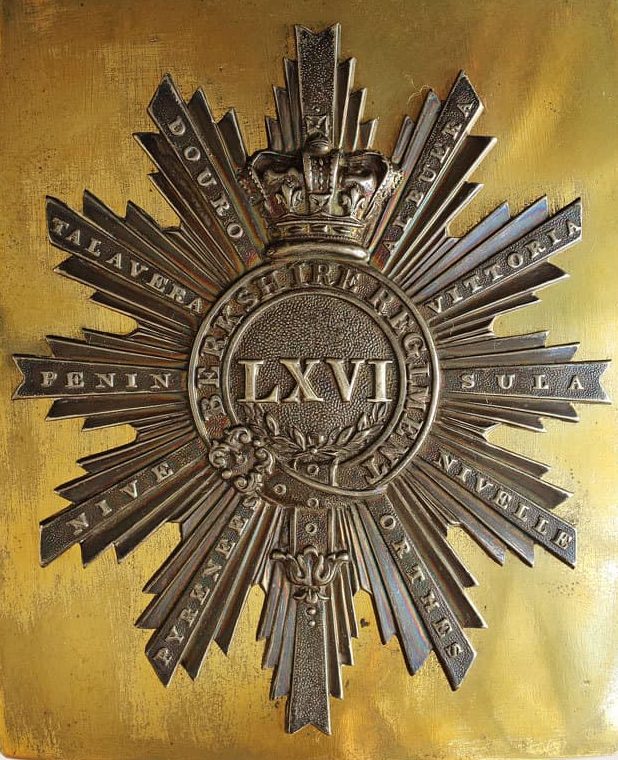Albuera
The battle of Albuera was the bloodiest and most costly engagement of the Peninsular campaign. On the 16th May 1811, the 66th went into battle more than 400 bayonets strong. By the end of the day, its losses were estimated at 320 or 80% casualties. British losses were 4,407 out of the 8,800 troops engaged.
By the end of the battle the Second Battalion HM 66th Regiment of Foot barely existed.
The French delivered the single largest attack of the Peninsular campaign as more than 8,400 French troops advanced in their traditional mass columns with skirmishers out in front. The French infantry attacking column was 50 men wide and 45 ranks deep. French flanking battalions were 25 men wide and 18 ranks deep and the whole force was accompanied by 3,500 cavalry and guns. It was an awesome sight that had terrified its opponents for over fifteen years on every battlefield in Europe.
The troops heard a noise that was dreaded more than any other on the battlefield: The sound of drumming hooves and jingling harness as the French cavalry swept towards them.

They had already experienced intense artillery fire, infantry charges and hand to hand combat; now the enemy cavalry caught them by surprise.
Lt. Crompton of the 66th wrote to his mother as a ‘miserable Lieutenant of the unfortunate 66th Regt’:
“It was then that our men began to waver, and for the first time (and God knows I hope the last) I saw the backs of English soldiers turned upon the French.”
The British troops, including the 66th in the centre, had no time to complete their change of direction or to form defensive squares. The on-coming riders of the notorious Polish Lancers, transfixed the living and the wounded on their lances and over ran the Brigade in a matter of minutes. The troops were first firing at no more than ten yards apart before charging bayonet to bayonet with the enemy but against cavalry these were almost useless. The 66th was annihilated where it stood in this dreadful slaughter. 1,300 men of the 1st Brigade were lost out of 1,600. Five regimental colours were taken by the French.

Beresford wrote in a letter:
“It is impossible by any description to do justice to the distinguished gallantry of the troops; but every individual nobly did his duty; and it is to be observed that our dead, particularly the 57th Regiment, were lying where they fought, in ranks, and every wound was in the front.”
The Regiment received its third battle honour of the war: Albuera.
Across the Pyrenees
Between the battle of Albuera in May 1811 and the crossing of the Pyrenees into France over two years later in July 1813, two more major battles were fought – Salamanca and Vittoria – and two sieges were raised – Cuidad Rodrigo and Badajoz. Salamanca cost over 3,000 casualties and Vittoria 3,500 but neither were as costly as Talavera (5365) or Albuera (5956). However, the capture of the two citadels has caused controversy ever since.
The Regiment received its fourth battle honour of the war: Vittoria and between November 1813 and February 1814, the 66th were involved in a number of sharp engagements up and down the border including:
The battles of Nivelle, Nive and Orthes
The troops moved into their positions by moonlight on the previous night and at 6am on the morning of the 10th November, the village’s bridge was first bombarded and then attacked. Fighting was fierce but by nightfall the crossing was complete and the troops camped for the first time on the soil of France.
Nive
The French retreated towards Bayonne and occupied high ground on both sides of the river Nive where Wellington attacked once more on the 9th December 1813. The fighting that followed was violent and confused as both sides sought advantage. At the bottom of the Hill of St Morguerre, Byng’s brigade faced odds of three to one and at first was pushed back until, at a critical moment, the 1st Provisional Battalion (31st /66th) was sent forward and Soult’s left wing was driven back.
Orthes
Soult now retreated to the city of Bayonne with 62,000 men as Wellington moved his army in a long loop eastwards to complete his encirclement of the city. The last stage of this manoeuvre would be to capture the bridge over the Gave de Pau in the small town of Orthes which would provide a crossing point for the troops.
Hill’s corps, including the 66th, made a series of feints against the bridge but a frontal attack would have cost too many casualties. Instead, the troops moved upstream where they crossed a ford and outflanked the French on the other side.
The Second Battalion received its fifth, sixth and seventh battle honours of the war: Nivelle, Nive and Orthes.

In the period between 1809 and 1814, when the Second Battalion had been in continuous action in the Peninsula, a total of 647 officers and men had been killed in action or had died of disease.
In 1815, the Second Battalion received its eighth and final battle honour, an umbrella award for its service: Peninsular 1809-1815.
The 66th was known as a reliable corps. On and off the battlefield from its first arrival in Portugal in 1809 to its final engagement in France in 1814, the 66th had not failed in its duty.
The war was now over and on the 6th July 1814, the Second Battalion sailed from Bordeaux to Cork in Ireland. In January 1816, after a period of rest, the Second Battalion sailed for St Helena under the command of Col. Dodgin arriving in May 1816 where it relieved the 53rd Foot (Shropshire). When the Regiment’s First Battalion arrived in St Helena from India in 1817 under the command of its long-serving commanding officer, Colonel Nichol, the two battalions amalgamated and the 66th mustered 1,200 men until April 1819 when it was reduced on orders from London and 400 men returned to England.

